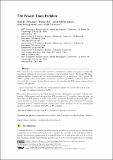| dc.contributor.author | Fermi, Ma | |
| dc.contributor.author | Schvartzman, Ariel | |
| dc.contributor.author | Waingarten, Erik | |
| dc.contributor.author | Demaine, Erik D | |
| dc.contributor.author | Aaronson, Scott | |
| dc.date.accessioned | 2017-12-21T19:58:26Z | |
| dc.date.available | 2017-12-21T19:58:26Z | |
| dc.date.issued | 2016-06 | |
| dc.identifier.issn | 1868-8969 | |
| dc.identifier.uri | http://hdl.handle.net/1721.1/112925 | |
| dc.description.abstract | When analyzing the computational complexity of well-known puzzles, most papers consider the algorithmic challenge of solving a given instance of (a generalized form of) the puzzle. We take a different approach by analyzing the computational complexity of designing a "good" puzzle. We assume a puzzle maker designs part of an instance, but before publishing it, wants to ensure that the puzzle has a unique solution. Given a puzzle, we introduce the FCP (fewest clues problem) version of the problem: Given an instance to a puzzle, what is the minimum number of clues we must add in order to make the instance uniquely solvable? We analyze this question for the Nikoli puzzles Sudoku, Shakashaka, and Akari. Solving these puzzles is NP-complete, and we show their FCP versions are Sigma_2^P-complete. Along the way, we show that the FCP versions of 3SAT, 1-in-3SAT, Triangle Partition, Planar 3SAT, and Latin Square are all Sigma_2^P-complete. We show that even problems in P have difficult FCP versions, sometimes even Sigma_2^P-complete, though "closed under cluing" problems are in the (presumably) smaller class NP; for example, FCP 2SAT is NP-complete. Keywords and phrases: computational complexity, pencil-and-paper puzzles, hardness reductions | en_US |
| dc.language.iso | en_US | |
| dc.publisher | Schloss Dagstuhl--Leibniz-Zentrum fuer Informatik | en_US |
| dc.relation.isversionof | http://dx.doi.org/10.4230/LIPIcs.FUN.2016.12 | en_US |
| dc.rights | Creative Commons Attribution 4.0 International License | en_US |
| dc.rights.uri | http://creativecommons.org/licenses/by/4.0/ | en_US |
| dc.source | Dagstuhl Publishing | en_US |
| dc.title | The fewest clues problem | en_US |
| dc.type | Article | en_US |
| dc.identifier.citation | Demaine, Erik D., et al. "The Fewest Clues Problem." 8th International Conference on Fun with Algorithms (FUN 2016), 8-10 June, 2016, La Maddalena, Italy, Dagstuhl Publishing, 2016. | en_US |
| dc.contributor.department | Massachusetts Institute of Technology. Computer Science and Artificial Intelligence Laboratory | en_US |
| dc.contributor.department | Massachusetts Institute of Technology. Department of Electrical Engineering and Computer Science | en_US |
| dc.contributor.mitauthor | Demaine, Erik D | |
| dc.contributor.mitauthor | Aaronson, Scott | |
| dc.relation.journal | Leibniz International Proceedings in Informatics | en_US |
| dc.eprint.version | Final published version | en_US |
| dc.type.uri | http://purl.org/eprint/type/ConferencePaper | en_US |
| eprint.status | http://purl.org/eprint/status/NonPeerReviewed | en_US |
| dspace.orderedauthors | Demaine, Erik D.; Ma, Fermi; Schvartzman, Ariel; Waingarten, Erik; Aaronson, Scott | en_US |
| dspace.embargo.terms | N | en_US |
| dc.identifier.orcid | https://orcid.org/0000-0003-3803-5703 | |
| dc.identifier.orcid | https://orcid.org/0000-0003-1333-4045 | |
| mit.license | PUBLISHER_CC | en_US |
